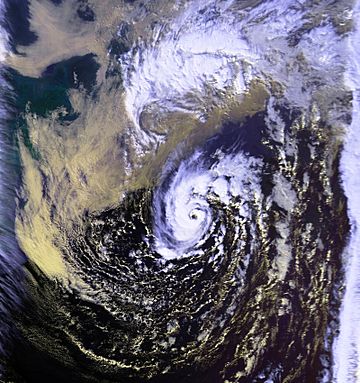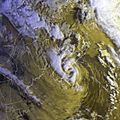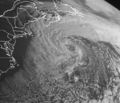1991 Halloween Nor'easter facts for kids
| Category 1 hurricane (SSHWS/NWS) | |

Halloween Nor'easter on November 1 at peak intensity.
|
|
| Formed | October 28, 1991 |
|---|---|
| Dissipated | November 2, 1991 |
| Highest winds | 1-minute sustained: 75 mph (120 km/h) |
| Lowest pressure | 980 mbar (hPa); 28.94 inHg |
| Damage | $208 million (1991 USD) |
| Areas affected | eastern United States, Atlantic Canada |
| Part of the 1991 Atlantic hurricane season | |
The 1991 Halloween Nor’easter, also known as the Perfect Storm, was a very unusual and powerful storm. It started as a type of storm called a nor'easter, which usually forms along the East Coast of North America. What made this storm special was that it changed forms several times. It even absorbed another hurricane and then turned into a small hurricane itself!
This unnamed hurricane was the last tropical storm of the 1991 Atlantic hurricane season and the fourth hurricane that year. By November 2, parts of Atlantic Canada felt the storm's strong winds and heavy rain. The storm caused about $208 million in damages in 1991 money, and sadly, 12 people died. Most of the damage happened when the storm was still a nor'easter, before it became a hurricane. It was the second most expensive storm of that season, after Hurricane Bob.
|
Tropical cyclones of the 1991 Atlantic hurricane season |
||||||||||||||||||||||||||||
|
|
|
|||||||||||||||||||||||||||
|
|
||||||||||||||||||||||||||||
Contents
What Was the Perfect Storm?
The Perfect Storm was a rare weather event that happened in late October and early November 1991. It got its nickname because several different weather systems came together at just the right time and place to create an extremely powerful storm.
How the Storm Formed
The storm began on October 28, 1991, as a regular low-pressure system off the coast of Nova Scotia, Canada. It grew stronger by getting energy from the warm waters of the Gulf Stream. At the same time, a cold front from the United States moved east and joined with the low-pressure system. This made the storm even bigger and more intense.
Another important part was Hurricane Grace, which was a tropical storm moving north. The Perfect Storm actually absorbed Hurricane Grace, taking its energy and moisture. This combination of a strong nor'easter, a cold front, and the remains of a hurricane created a truly "perfect" (meaning perfectly bad) storm.
When It Became a Hurricane
Even though it started as a nor'easter, the storm later gained characteristics of a tropical cyclone. This means it developed a warm core and a more circular shape, like a hurricane. On November 1, 1991, the storm officially became a small hurricane, even though it was already causing a lot of damage as a nor'easter. It only lasted as a hurricane for a short time before weakening.
Impact and Damage
The Perfect Storm caused a lot of problems along the East Coast of the United States and in Atlantic Canada.
Coastal Flooding and Erosion
The storm brought huge waves and very high tides, leading to severe coastal flooding. Many homes and businesses along the coast were damaged or destroyed by the rising water. Beaches were eroded, meaning sand was washed away, changing the coastline. Places like Ocean City, New Jersey, experienced significant street flooding.
Loss of Life
Sadly, 12 people died because of the storm. Some were fishermen lost at sea, and others were caught in the dangerous conditions on land. The most famous story is about the fishing boat Andrea Gail, which was lost at sea with all its crew during the storm. This event was later made into a book and a movie.
Rescue Efforts
The United States Coast Guard played a big role in rescuing people during the storm. They helped save sailors from sinking ships and even rescued the crew of an Air National Guard helicopter that crashed during a rescue mission. The Tamaroa was one of the Coast Guard cutters involved in these brave rescue operations.
Why Was It So Unusual?
The 1991 Halloween Nor'easter was unusual because it combined features of different types of storms. It started as a non-tropical storm (extratropical), then absorbed a tropical storm, and finally turned into a small hurricane itself. This kind of transformation is very rare. Most storms either stay tropical (like hurricanes) or extratropical (like nor'easters), but this one did both!
Images for kids
-
Oceanfront flooding in Ocean City, New Jersey on October 31.
-
Tamaroa, a Coast Guard cutter that rescued the crew of a downed Air National Guard helicopter
See also
 In Spanish: Tempestad de Halloween de 1991 para niños
In Spanish: Tempestad de Halloween de 1991 para niños







